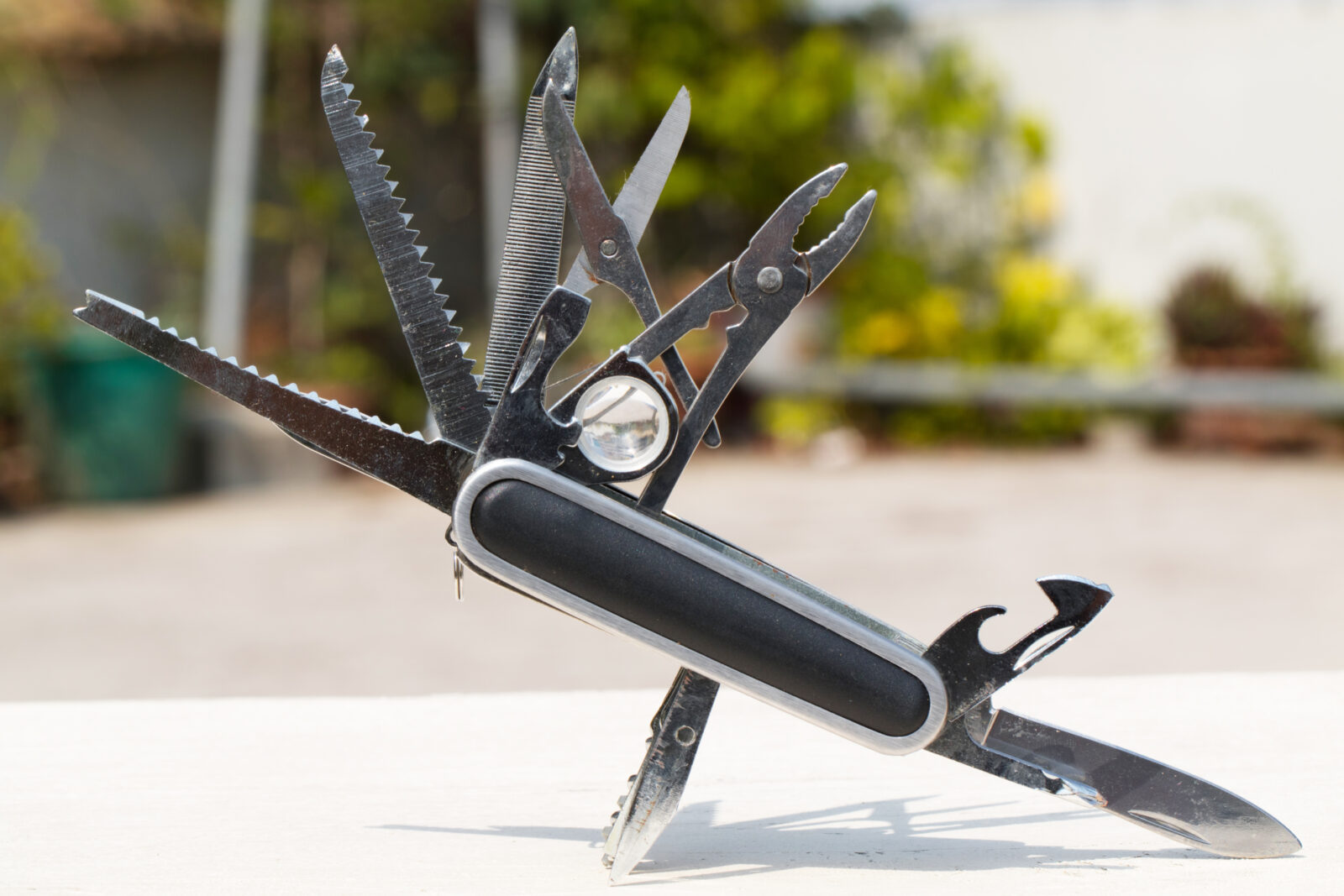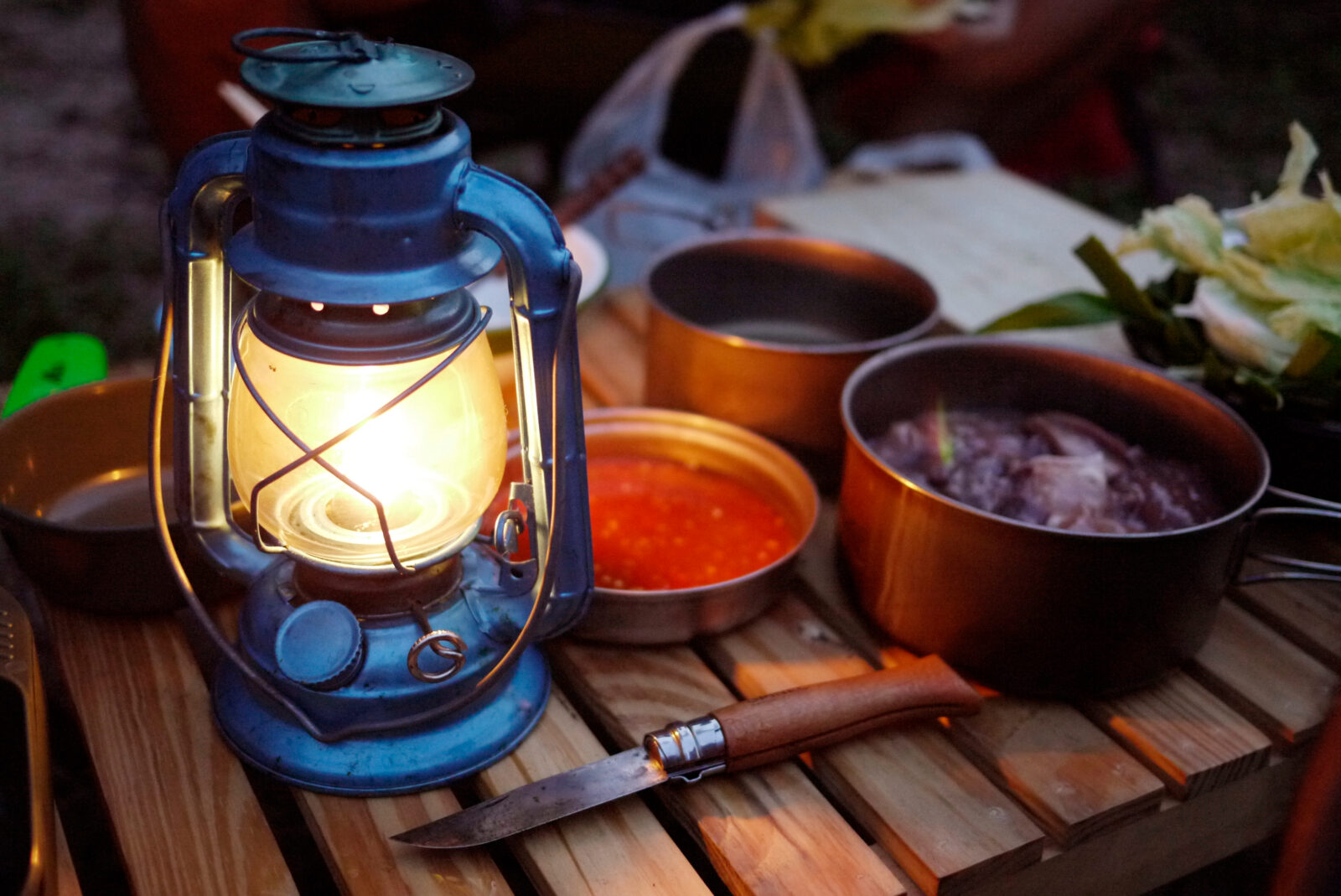Getting a walkie-talkie to communicate while camping?
You’re on the right page.
Walkie-talkies are, or handheld radios are a necessity if you’re looking to communicate at the campsite. For many beginner campers, they can be difficult to shop for because walkie-talkies are so jam-packed with features.
Here are three features that make for a good two-way handheld radio :
- Lots of radio channels. Great walkie-talkies allow you to communicate on at least ten different frequency channels.
- Waterproofing. They should be at least water-resistant, if not completely waterproof to handle the rigors of the outdoors.
- Long battery life. A good walkie-talkie should have a battery that lasts for eight or more hours.
To make things even easier for you, we put together a detailed buyer guide so you know what to look for as you shop.
Our top walkie-talkie picks
Budget Option : Midland T10
“An affordable price and an assortment of different functions.”
Value for Money : Motorola T200
“Choose between 22 channels with a range of up to 20 miles in the mountains.”
Compact Sized : Uniden SX167
“A small GMRS/FRS radio that allows you to choose from 22 different channels and NOAA weather alerts.”
Best Features : BaoFeng UV-5RE+
“A fully-featured radio for campers that like to have full control over their communication abilities.”
Best for Long Range : Midland TT61VP3
“32 miles of range, plus good mountain performance.”
Best in the Mountains : Backcountry Access BC Link
“A high-end walkie talkie designed specifically for use in the mountains.”
Best for Harsh Conditions : Motorola T600 H20
“Boasts a fully waterproof IP67-rated design that even floats if it’s dropped in the water.”
Midland T10
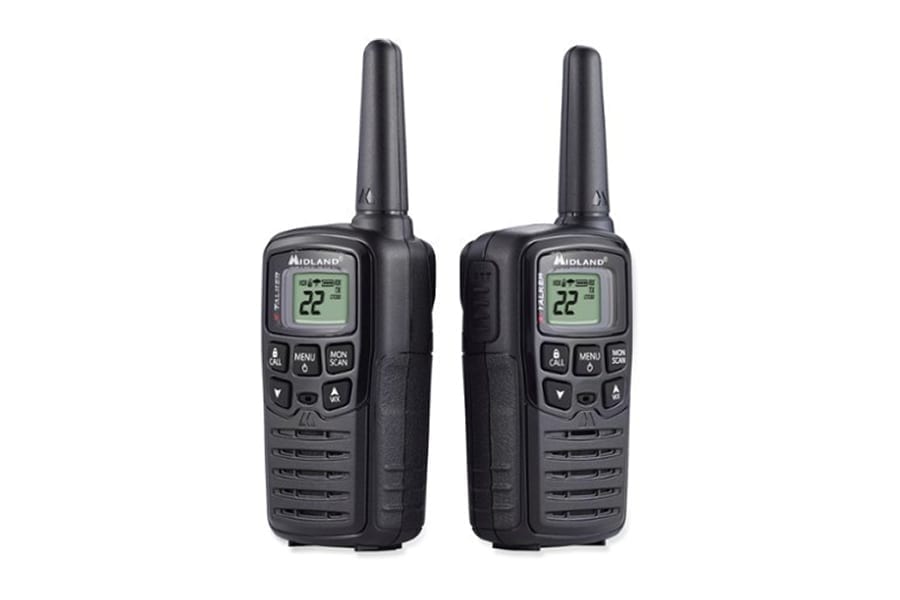
- Range : 20 miles
- Battery Type : AAA
For budget-conscious campers, the Midland T10 is a solid choice. Featuring an affordable price and an assortment of different functions, these walkie talkies allow for easy communication with people that are up to 20 miles away.
One of the key benefits of these radios is their range of channels. They operate on GMRS/FRS frequencies and have 22 different channel options. This makes them ideal for campers that spend a lot of time in busy locations with lots of radio traffic.
Additionally, the Midland T10 can scan channels for traffic and provide All Hazards Alerts so you can stay informed. They also offer NOAA weather channels, which is useful if you’re planning on spending a lot of time in remote locales.
What we like
- Many channel options for improved communication.
- Affordable. Great budget-friendly price that doesn’t skimp on features.
- Hazard alerts. Provides real-time updates on hazards and weather.
What we don't like
- Not rechargeable. Uses only disposable batteries.
Motorola T200
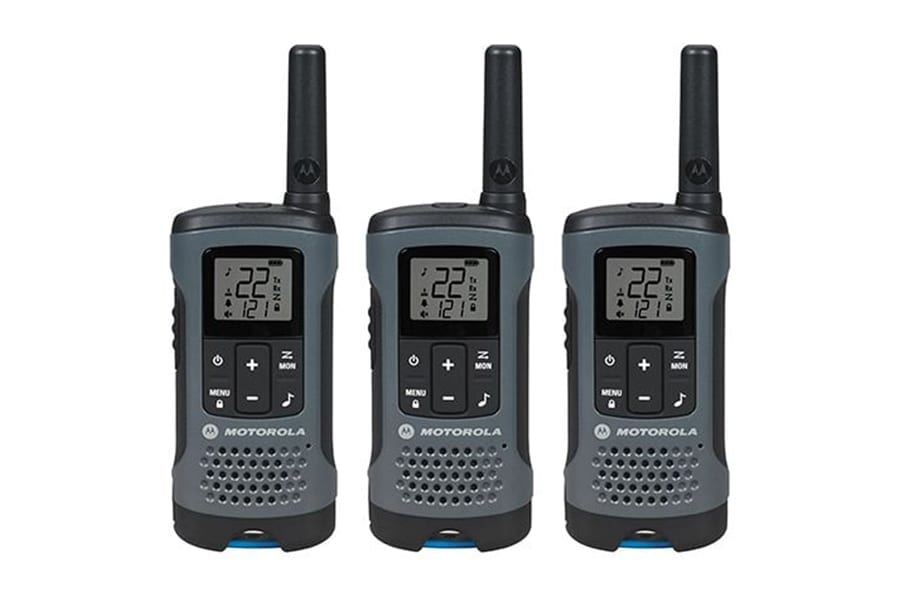
- Range : 20 miles
- Battery Type : Rechargeable and AA
The Motorola T200 is great value for the money when it comes to communicating with others in the backcountry. This two-pack of walkie-talkies comes ready to go out of the box and allows for either GMRS or license-free FRS radio transmissions.
With these radios, you can choose between 22 channels with a range of up to 20 miles in the mountains. They operate with 121 privacy codes and allow for direct communication with other radios on the same frequency, regardless of brand.
Plus, the Motorola T200 can be used with either the included NiMH rechargeable batteries or with AA batteries. That way, you can ensure that you always have power for your radios, even if you’re far from a charging source.
What we like
- Lots of privacy codes for uninterrupted communication.
- Rechargeable or AA batteries allow plenty of flexibility for power.
- Great value. Includes two radios for an affordable price.
What we don't like
- No NOAA weather alerts for staying informed about conditions.
Uniden SX167
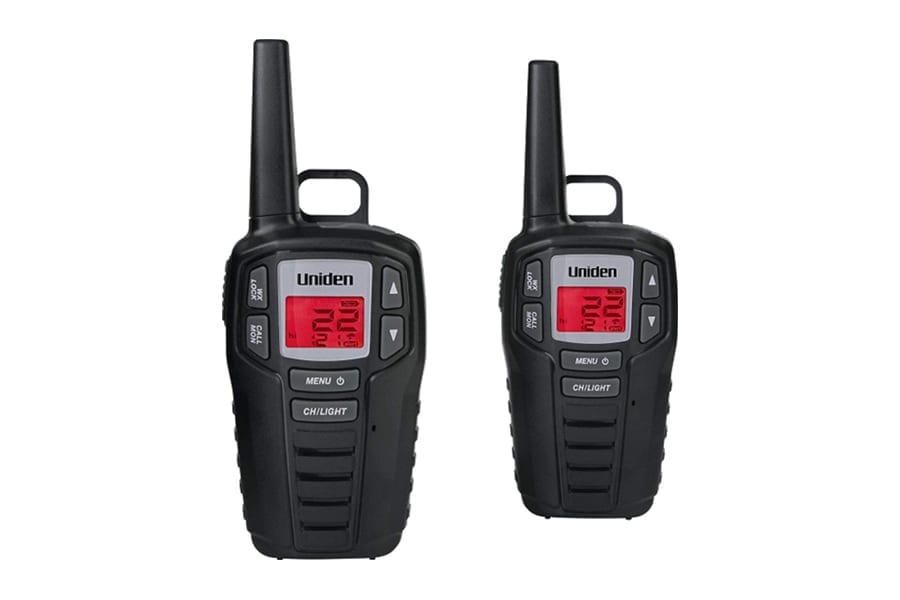
- Range : 16 miles
- Battery Type : Rechargeable
If you’re looking for a walkie talkie with a compact size for emergency use, then the Uniden SX167 might be what you need. This GMRS/FRS radio allows you to choose from 22 different channels and NOAA weather alerts so you can find a frequency that is free when you need it most.
With this radio, you can communicate with others that are up to 16 miles away. For ease of use you can stick to just channels 7 to 14, which operate under FRS and don’t require an FCC license.
A great feature of the Uniden SX167 walkie talkie is its rechargeable battery. You can even use the included USB mini cable to recharge your radio from a portable battery pack to ensure that you never run out of power in the mountains.
What we like
- License-free operation if you use only channels 7 to 14.
- USB rechargeable. Can be charged from a portable battery pack.
- NOAA weather alerts for staying informed while outside.
What we don't like
- Minimal water resistance isn’t great for wet environments.
BaoFeng UV-5RE+
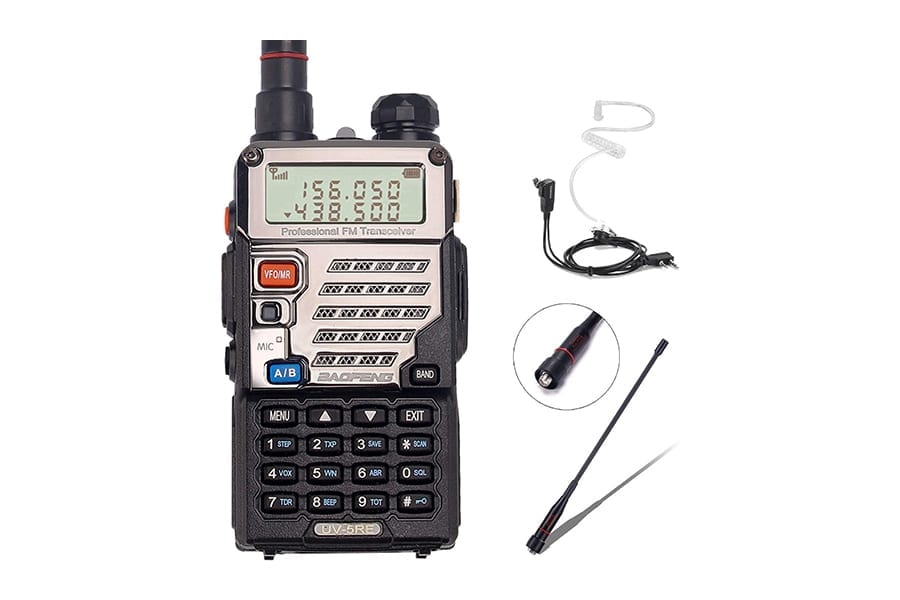
- Range : 12 miles
- Battery Type : Rechargeable
The BaoFeng UV-5RE+ is a fully-featured radio for campers that like to have full control over their communication abilities. With these handheld radios, you can choose between VHF and UHF transmissions, allowing you to get the best range, whether you’re in a tree-filled valley or out on a large plateau.
This model features three power settings and up to 12 miles of range in open conditions. You can choose from 128 channels for communication and you can get NOAA Weather Alerts while on a remote trip in the mountains.
Thanks to the BaoFeng UV-5RE+’s keypad, you can input custom frequencies without having to flip through channels for ease of use. It also has a large LCD display screen so you can more easily view and change your channel settings.
What we like
- UHF and VHF compatibility allows for excellent range.
- Lots of channels. 128 different frequencies to choose from.
- Keypad input. Makes changing to specific channels much easier.
What we don't like
- Bulky. Large packed size and heavy weight (1.1lbs/499g).
Midland TT61VP3
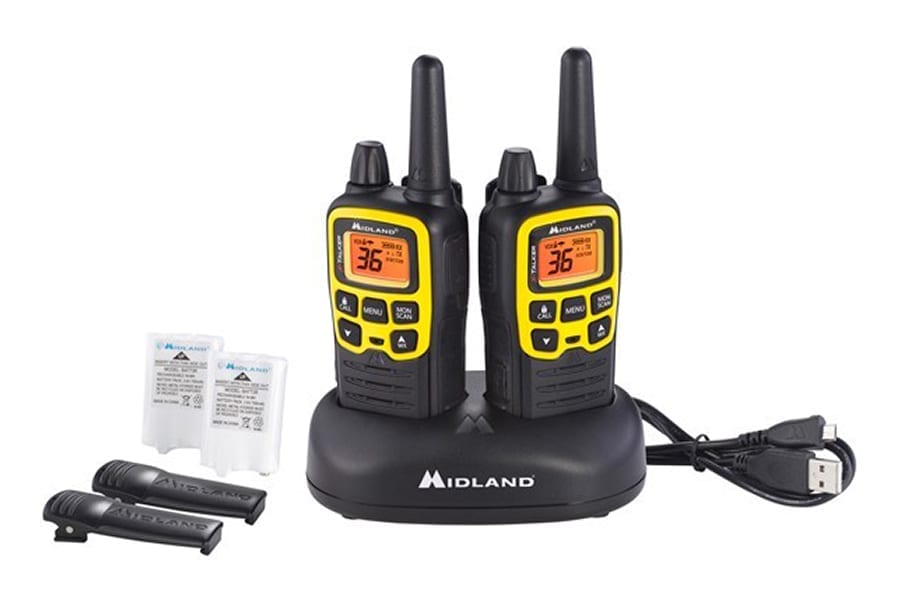
- Range : 32 miles
- Battery Type : Rechargeable
Designed specifically with mountain use in mind, the Midland TT61VP3 are a good choice for outdoor recreationalists that need a powerful communication tool.
These radios can access 36 different channels, 7 of which are FRS only and do not require an FCC license. They also provide 121 privacy codes, NOAA Weather Alerts, and will scan through different channels to keep you up to date on all of the latest news.
For easy charging, the Midland TT61VP3 comes with a desktop cradle that can power up both walkie talkies at the same time. Additionally, the set includes a micro-USB cable so you can charge them using a portable power pack while you’re on the go.
What we like
- Many channel options. 36 channels to choose from.
- Charging station. Includes desktop charger for ease of use.
- Great range. 32 miles of range, plus good mountain performance.
What we don't like
- Limited battery life on standby with just 10 hours.
Backcountry Access BC Link
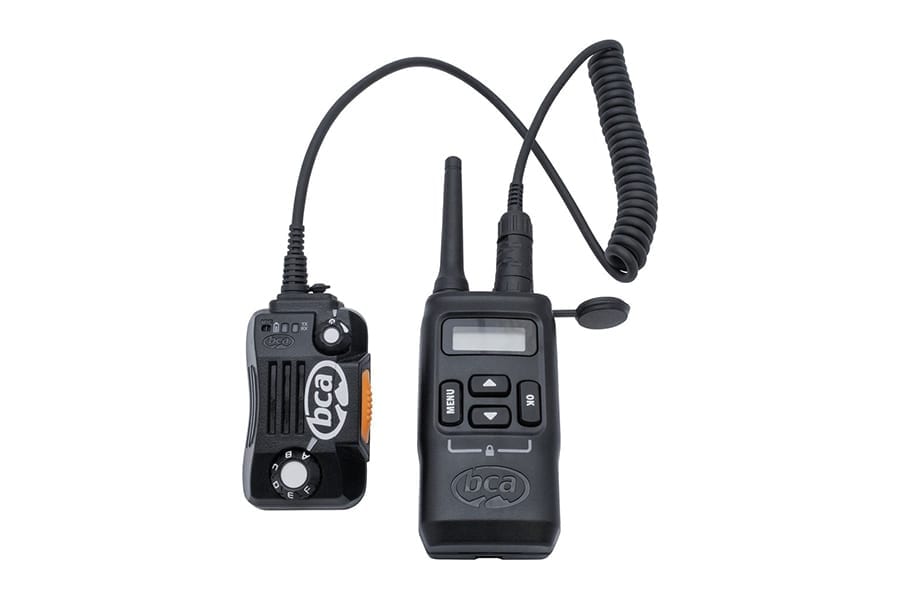
- Range : 2.5 miles
- Battery Type : Rechargeable
The Backcountry Access BC Link is a high-end walkie-talkie designed specifically for use in mountain environments. This radio allows for two-way communication on 22 FRS and GMRS channels with 121 privacy codes.
It is both water and dust-resistant and is crafted to securely clip onto a backpack. Thanks to its included microphone, which can be attached to a pack shoulder strap, you can keep the radio in your backpack to protect it from the elements.
With 140-hour battery life, the Backcountry Access BC Link boasts some of the longest-running time in the industry. Plus, it can function at temperatures as low as -4ºF (-20ºC), which makes it a particularly good radio for backcountry skiing or wintertime mountaineering.
What we like
- Microphone included. Allows for easier talking.
- Long battery life of 140 hours for all-day use.
- Durable. Operates in temperatures down to -4ºF (-20ºC).
What we don't like
- Limited Range. Only 2.5 miles of talking distance.
Motorola T600 H20
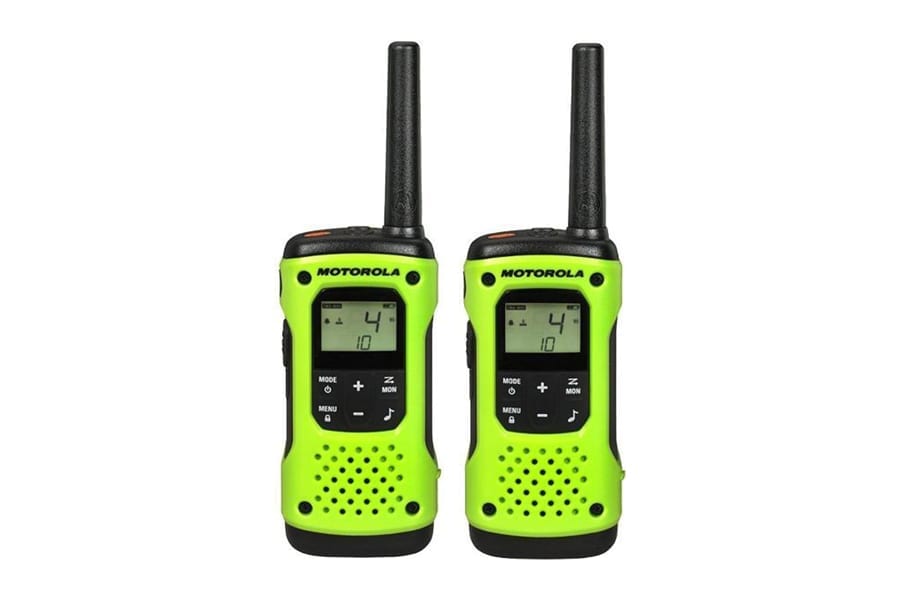
- Range : 35 miles
- Battery Type : Rechargeable and AA
Versatile, yet easy to use, the Motorola T600 H20 is a fully-featured set of 2 walkie talkies for extreme environments. It boasts a fully waterproof IP67-rated design that even floats if it’s dropped in the water.
This radio can be used on 22 different channels with 121 privacy codes for uninterrupted communication with others. Additionally, it has an impressive 35 mile maximum range when used in open locations.
The Motorola T600 H20 radio is also packed full of features, including NOAA Weather alerts and iVox hands-free communication technology. Finally, it comes with an emergency alert button that can be deployed to send out a sound that alerts others to your location if you’re hurt and need help while in the mountains.
What we like
- Long range. Up to 35 miles of talking distance.
- Waterproof. IP67 design floats and is completely waterproof.
- Emergency alert. Sends distress signals if you’re in danger.
What we don't like
- Bulky. Large size is heavier and more difficult to pack.
Walkie Talkies Buying Guide
Walkie talkies are one of the most complex pieces of gear you can buy. So, it’s critical that you understand the basics of camping radios before you commit to a specific model for your needs.
Here are the 7 most important things you should know before buying your camping walkie talkie.
Range and clarity
All camping walkie talkies will have a claimed range, or maximum distance that they can transmit signals, allowing you to communicate with others. These ranges can vary quite widely, from the 2.5 mile range of the Backcountry Access BC Link to the 35 miles of the Motorola T600 H20.
Generally speaking, a radio with a longer range is preferred because it allows you to communicate with people who are further away. However, it’s important to keep in mind that claimed range is very different from the actual range that you’ll get when you use your radio in the real world.
When radio manufacturers test the range of their devices, they do so in an open area without obstructions, such as buildings, mountains, or heavy tree cover. Therefore, the range that’s listed on a radio’s specs is what you can hope to get in perfect conditions.
In reality, perfect conditions are hard, if not impossible to come by. Instead, the actual range of your radios will be significantly less than their claimed range.
If you’re travelling in rugged terrain below treeline, you can expect that your range will be limited to no more than 2 to 3 miles. On the other hand, if you’re above treeline near a mountain summit, you can often get transmitting distances that are close to your radio’s claimed range.
Number of radio frequency bands
The world of radio frequency band is quite complex, so here’s what you need to know :
VHF vs UHF
Modern radios operate within VHF (Very High Frequency) or UHF (Ultra High Frequency) channels. The difference between the two is that UHF provides better communication over short distances, particularly within urban areas and valleys.
Alternatively, VHF is preferred for long-distance communication.
The majority of radios are single band, which means they operate solely within either VHF or UHF frequencies. However, some, like the BaoFeng UV-5RE+ are dual banded, so they can switch between UHF and VHF channels.
Dual band walkie talkies are useful if you plan to also use them for maritime use or for long-distance talking. Keep in mind that many VHF channels are reserved for emergency or official purposes, so you’ll likely need a license to operate this type of radio.
GMRS vs FRS
GMRS (General Mobile Radio Service) and FRS (Family Radio Service) are two types of radio services found within the United States. They both allow for two-way communication and include frequencies between 462 MHz and 467 MHz.
The major difference between the two is that GMRS provides longer talking range while FRS is best for very short distance communications.
Additionally FRS radio use doesn’t require an FCC license while GMRS does.
Most camping walkie talkies, like the Motorola T200 H20 allow for both GMRS and FRS use. Others, such as the Uniden SX167, have some FRS-only channels, so they can be used right out of the box without the need for a license.
Number of radio channels
Radio channels are the different frequencies that you can use to communicate with others. Most handheld radios have more than 10 channels, which can be considered the minimum for regular backcountry use.
Generally speaking, the more channels, the better, because it allows you more options for communication if there are many other people trying to communicate at the same time.
Some radios, such as the Midland T10, have 22 channels, which is more or less the standard for camping walkie talkies that use both GMRS and FRS. Others, like the Midland TT61VP, have 36 channels, which is helpful if you’re traveling to popular camping spots.
Privacy and interference codes
Privacy codes (a.k.a. Interference codes) are sort of like a sub-channel that you can use to ensure that you can communicate directly with people in your group without having to listen to others on the same frequency.
While these codes don’t stop people from listening into your conversations, nor do they allow you to talk on a frequency when someone else in range is talking, they are helpful if you want to keep noise traffic on your radio to a minimum.
Most radios will come with between 10 to 150 interference codes, such as the 121 codes that come with the Motorola T200 H20. This is particularly helpful if you camp in very popular destinations.
Battery life
Radios don’t work without charged batteries, so a model that has a longer battery life is helpful.
8 hours of battery life should be considered a minimum for a quality camping walkie talkie.
With that in mind, alkaline batteries (e.g., AA and AAA) tend to have longer battery lives than rechargeable alternatives. That being said, some rechargeable models, like the Backcountry Access BC Link, have an impressive 140 hours of battery life.
Additionally, you can always bring a portable power bank with you into the backcountry if you’re camping for more than a day to juice up your radio and keep it at full charge.
Design
With radios, you have two choices;
- Simple, user-friendly design with few buttons and custom controls
- Fully-featured design that allows you full flexibility over your communication device.
Having more buttons and a keypad is useful if you want to type in specific communication frequencies, but it does make using the radio much more complicated to use.
The placement of the buttons (especially the push-to-talk button) is important, as you want it to be located on the side of the radio where it’s not likely to be accidentally pushed but is still easy to access with one hand.
Other things to keep in mind include the weight and size of a radio. Models that are about the size of a deck of cards are generally the most portable options, though they tend to have less range than their bulkier counterparts.
Additionally, fully featured models with keypads and extra control buttons are usually heavier (around 1lb/450g) while simpler models will be considerably lighter at around 6oz (170g).
Waterproofing
Most radios will offer some amount of water-resistance, while others will be completely waterproof. To learn about the waterproofing of a walkie talkie, you’ll want to look at its IP rating.
IP ratings have two digits, the first of which refers to its dust-proofing and the second of which relates to the object’s waterproofing. The higher the number, the more water and dustproof an object is.
So, an object with a rating of IP34 would be less dust and waterproof than one with an IP67 rating. For complete waterproofing, look for walkie talkies with ratings of IP67 or higher, such as the Motorola T600 H20, as the 7 in the second digit means that it can be submerged in water up to 3ft (1m) deep for at least 30 minutes.
Emergency features
Camping radios, including the Midland T10, often come with emergency features, such as NOAA Weather Alerts or All Hazard Alerts.
- NOAA weather alerts are helpful if you’re planning to be away from cell service for a while as they can give you information about incoming weather systems.
- All hazards alerts, on the other hand, provide information about natural disasters, wildfires, nuclear disasters, and Amber Alerts, which is helpful for staying informed even in remote environments.
FAQ
Do I need a license to operate my radio?
You need a license from the FCC to operate a radio in the USA if your radio uses GMRS (General Mobile Radio Service) and VHF channels, but not if it only uses FRS (Family Radio Service) or CB (Citizens Band) frequencies.
Can a walkie talkie be hacked?
Most walkie talkie sets (e.g., two devices that communicate with only each other) can be hacked because they aren’t built with extensive security controls. Regular two-way radios for commercial use operate on public frequencies and are also vulnerable to hackers.
Which walkie talkie channel should I use?
It’s generally best to use the lowest radio frequency (e.g., lowest channel number) available to your walkie talkie because they have the best range. Keep in mind that some channels are controlled and can only be used for emergencies, not regular communication.
Gaby Pilson
Gaby is a professional mountain guide with a master’s degree in outdoor education. She works primarily in the polar regions as an expedition guide, though she can be found hiking, climbing, skiing, sailing, or paddling in some of the world’s most amazing places when not at work.
